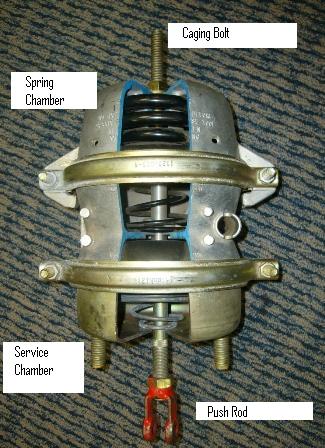
Spring brakes have a simple function. Note FMCSR, Part 393, Section 393.41(b)
(b) Air-braked power units manufactured on or after March 1, 1975, and air-braked trailers manufactured on or after January 1, 1975. Each air-braked bus, truck and truck tractor manufactured on and after March 1, 1975, and each air-braked trailer except an agricultural commodity trailer, converter dolly, heavy hauler trailer or pulpwood trailer, shall be equipped with a parking brake system as required by FMVSS No. 121 (S5.6) in effect at the time of manufacture. The parking brake shall be capable of holding the vehicle or combination of vehicles stationary under any condition of loading in which it is found on a public road (free of ice and snow). An agricultural commodity trailer, heavy hauler or pulpwood trailer shall carry sufficient chocking blocks to prevent movement when parked.
The spring, capable of exerting about 2,200 pounds of pressure, is held in a compressed position by a diaphragm that has air opposite the spring; that air chamber having 35 pounds or more holds the spring in that compressed position.
When air is exhausted, the spring expands, pushing the plate that extends the push-rod, that rotates the slack adjuster, and thus the cam rod, the s-cam that extends the shoes, that have the linings attached. The linings in turn contact the drum. In theory this is the parking brake system that (as required) holds the equipment in place.
Springs are not brakes. They only activate the same mechanical parts of the overall mechanical system that the air system activates. The springs cannot change the stroke (adjustment), thus if brakes are out of adjustment, they will stay out of adjustment.
Springs are not emergency brakes. They only apply the same service brakes that the air system does. Of interest; drivers can activate springs at any speed. The activation will not turn on brake lights. Drivers can and often do start the truck in motion with the transmission in a higher gear than first, using throttle as the clutch engages, and this can cause the truck to overcome an extended spring (leaking diaphragm) and a fire can result.
Spring brakes are not required on every axle. Spring activation of brakes has been around for more than 50 years, yet drivers as a rule don’t know much about them, so questions and answers are sometimes very interesting.
On our cutaway, you can see the spring in a caged position. This is the position that air puts it in. It is also the position that caging bolts put it in when a tow truck or a mechanic wants to tow the truck or work on that part of the system (for example, replacing a diaphragm). This should also show you that caging does not affect the adjustment on that wheel. No matter how or why the spring is extended, it can only push the rod to the limit of the adjustment setting of the slack adjuster. An interesting question; Do the springs give you more or less braking that the air pressure? Answer; Less if maximum air is applied.

